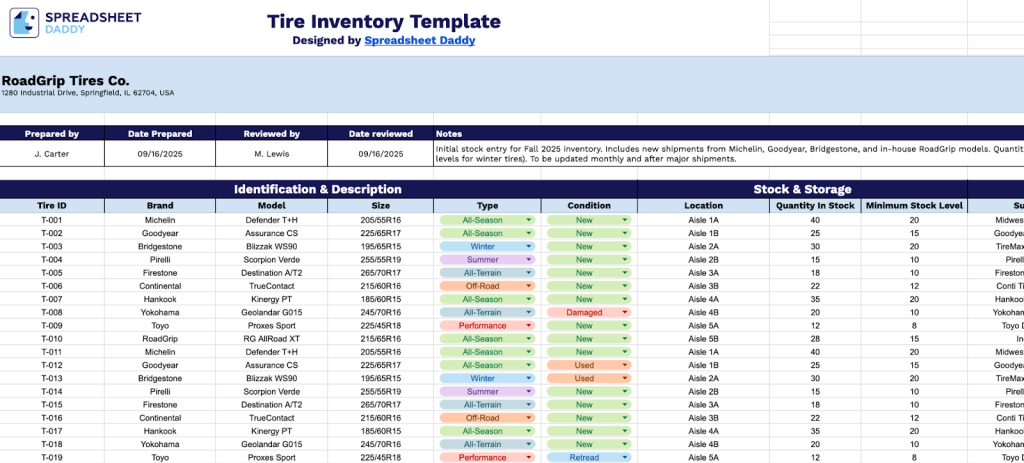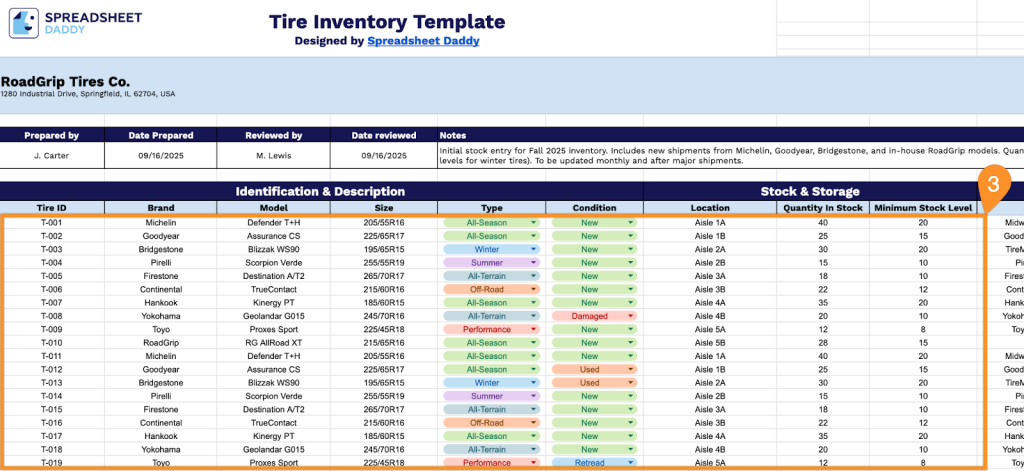Managing tire inventory can become overwhelming quickly. Expensive software systems are often overkill for many shops, and manually tracking stock levels leads to costly mistakes and missed sales.
A spreadsheet provides a simple and customizable way to monitor your tire inventory, pricing, and stock levels, eliminating the complexity and cost associated with specialized software.
That’s why we’ve created a free tire inventory spreadsheet template that makes tracking your tire stock straightforward and stress-free.
Quick Jump
ToggleWhat Is a Tire Inventory Spreadsheet?

A tire inventory spreadsheet is essentially a digital organizer for tracking your tire stock. Think of it as a detailed list that keeps all your important tire information, such as brands, sizes, quantities, storage locations, and prices, neatly arranged in rows and columns.
What makes it great is that you don’t need fancy (and costly) inventory software to stay organized. Most people already know how to use spreadsheets, so there’s no learning curve or monthly fees to worry about. You can easily see which tires are running low, check prices, and keep everything updated as you sell or restock.
It’s especially useful for smaller tire shops, mechanics, or anyone managing a fleet who wants to stay on top of their inventory without dealing with complicated systems or breaking the bank.
Why Use Our Tire Inventory Spreadsheet Template?
- Stop wasting time looking for tires: You’ll know exactly what’s in stock and where to find it, so customers aren’t waiting around while you dig through the shop.
- Get your whole team on the same page: Anyone can jump in and update inventory without scratching their heads or messing things up.
- Catch problems before they become headaches: Spot damaged or questionable tires upfront instead of discovering issues when a customer’s already at the counter.
- Start today, not next month: Skip the hassle of building your own system, just plug in your tire info and you’re good to go.
Download Spreadsheet Daddy’s Free Tire Inventory Management Spreadsheet

This tire inventory template is like having a dedicated inventory manager who never takes a day off. It keeps track of everything you need to know about your tires, from what brands and sizes you have to where exactly they’re sitting in your warehouse.
The layout is straightforward and practical. You can log each tire’s details (brand, model, size, what kind of shape it’s in), track how many you actually have versus how many you should have, and keep all your supplier info and pricing in one place.
There’s even space for those little notes that matter, like “these wear faster” or “customer complained about road noise.”
What’s included
- Everything you need to get started: A clean header where you can add your company info, plus spots to track who set it up and when it was last checked, so there’s no more guessing about outdated data.
- All the tire details that actually matter: Simple columns for tire ID, brand, model, size, type, and condition so you can find exactly what you’re looking for without digging through messy records.
- Never run out of stock again: Track where each tire is stored, how many you have, and set minimum levels so you know when it’s time to reorder before you’re caught empty-handed.
- Keep your money straight: Built-in spots for supplier info, what you paid, and what you’re charging so you can see your profit margins and know who to call when you need more inventory.
- No confusing mess: Everything’s organized into logical sections that make sense because product info, storage details, and money stuff are all separated, so you can find what you need fast.
- Room for the stuff that doesn’t fit: A notes section where you can jot down anything special, like when a tire has a small defect, or a customer has it on hold, or whatever else you need to remember.
How to Use Our Tire Inventory Spreadsheet Template
1. To get started, either download the Excel or PDF version of the template or copy the Google Sheets file.
2. Fill in your company name and address at the top, then add who prepared the inventory and when it was completed. Include the reviewer’s name and review date, and feel free to add any notes or additional information in the notes section.

3. After that, provide the information for the fields:
- Tire ID
- Brand
- Size
- Type
- Condition
- Location
- Quantity In Stock
- Minimum Stock Level
- Supplier
- Unit Cost
- Retail Price
- Notes (if needed)
